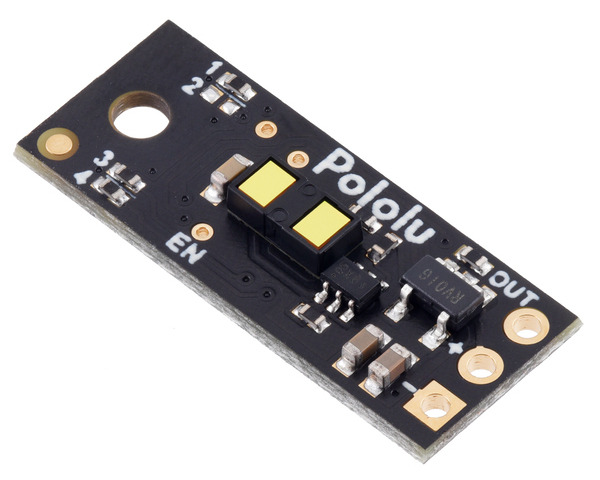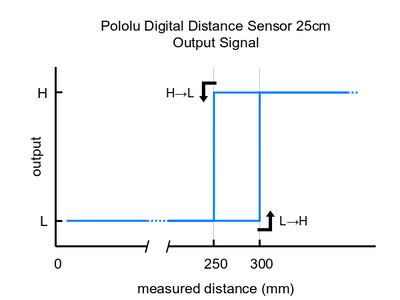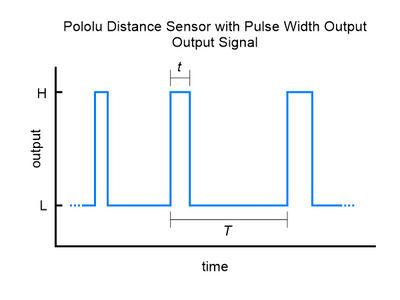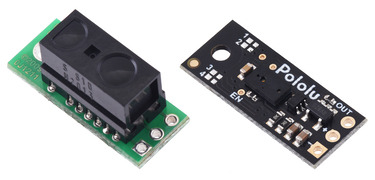Sensors » Proximity Sensors and Range Finders » Pololu Digital Distance Sensors »
Pololu Distance Sensor with Pulse Width Output, 300cm Max
This small lidar-based distance sensor reports the distance of objects up to about 300 cm (120″) away with a pulsed signal similar to a hobby servo control signal. A digital microcontroller pin can be used to time the length of each high pulse, which encodes the measured distance. The sensor works over an input voltage range of 3.0 V to 5.5 V, and the 0.1″ pin spacing makes it easy to use with standard solderless breadboards and 0.1″ perfboards.
Note: The maximum range of 300 cm is only achievable for high-reflectance objects in good ambient conditions. Lower-reflectivity targets or poor ambient conditions will reduce the maximum range.
Alternatives available with variations in these parameter(s): maximum range connector Select variant…
| Description | Specs (12) | Pictures (16) | Resources (4) | FAQs (0) | On the blog (1) | Distributors (41) |
|---|
Overview
 |
Pololu Distance Sensor with Pulse Width Output, 300cm Max. |
|---|
This compact sensor makes it possible to measure the distance of objects up to about 300 cm (120″) away using a simple digital pulse width interface (similar to a hobby servo control signal). It uses a short-range lidar module to precisely measure how long it takes for emitted pulses of infrared, eye-safe laser light to reach the nearest object and be reflected back, allowing for 2 mm resolution. As long as the sensor is enabled, it takes continuous distance measurements and encodes the ranges as the widths of high pulses, which can then be timed by a microcontroller using a single digital input.
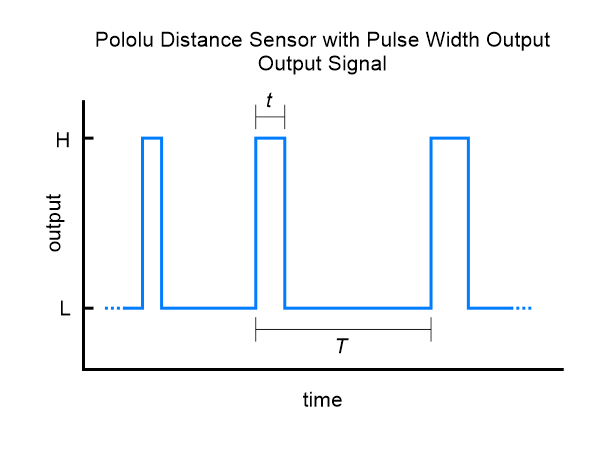 |
 |
A camera with no IR filter shows the infrared light emitted by a Pololu Digital Distance Sensor (this light is eye-safe and not visible to the naked eye). |
|---|
The relationship between measured distance d (in mm) and pulse width t (in µs) is as follows:
``d = (4 text( mm)) / (1 text( µs)) * (t – 1000 text( µs))``
``t = 1000 text( µs) + (1 text( µs)) / (4 text( mm)) * d ``
The timing uncertainty is approximately ±5%. As objects approach the sensor, the output pulse width will approach 1.0 ms, while an object detected at 300 cm will produce a 1.75 ms pulse width. The sensor uses a pulse width of 2.0 ms to indicate no detection. The pulse period T ranges from around 30 ms to 33 ms, depending on the proximity of the detected object.
The maximum detection range depends on object reflectivity and ambient lighting conditions. In our tests, the sensor was able to reliably detect a wall out to around 300 cm away, a white sheet of paper out to around 170 cm, and a hand out to around 100 cm. The following graph shows the measured distances of three units versus their actual distances from a variety of targets at several different ranges:
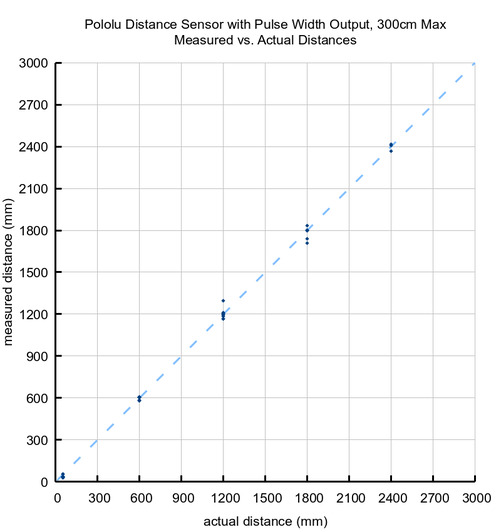 |
Please note that while this sensor can detect objects to within about 1 mm of the sensor face, the effective minimum distance it can measure is around 4 cm, so objects closer than 4 cm might result in an inaccurate measurement.
This sensor has 0.1″-pitch through holes that are compatible with 0.1″ headers. A functionally identical version is also available with a side-entry connector that works with our 3-pin JST SH-style cables.
Specifications
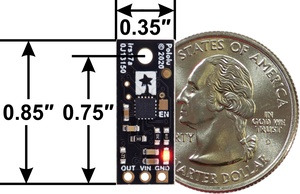 |
- Operating voltage: 3.0 V to 5.5 V
- Current consumption: 30 mA (typical) when enabled, 0.4 mA when disabled
- Maximum range: approximately 300 cm (120″) (for high-reflectivity targets in good ambient conditions; lower-reflectivity targets or poor ambient conditions will reduce the maximum detection range)
- Minimum range: 4 cm (for accurate measurement); < 1 mm (for detection)
- Resolution: 2 mm
- Update rate: 30 Hz to 33 Hz (33 ms to 30 ms period)
- Field of view (FOV): 15° typical; can vary with object reflectance and ambient conditions
- Emitter: eye-safe, 940 nm invisible Class 1 VCSEL (vertical cavity surface-emitting laser)
- Output type: digital pulse width
- Dimensions: 0.85″ × 0.35″ × 0.136″ (21.6 × 8.9 × 3.5 mm); see the dimension diagram (193k pdf) for more information
- Weight: 0.015 oz (0.4 g)
Using the sensor
 |
Important note: This product might ship with a protective liner covering the sensor IC. The liner must be removed for proper sensing performance.
Three connections are necessary to use this module: VIN, GND, and OUT. These pins are accessible through a row of 0.1″-pitch through holes, which work with standard 0.1″ (2.54 mm) male headers and 0.1″ female headers (available separately). The VIN pin should be connected to a 3 V to 5.5 V source, and GND should be connected to 0 volts. The sensor outputs its digital pulses on the OUT pin. The low level of the pulses is 0 V, and the high level is VIN. A red LED on the back side of the board also lights whenever an object is detected (the closer the object, the brighter the LED).
 |
The board has an optional ENABLE pin that can be driven low to put it into a low-power state that consumes approximately 0.4 mA. This pin can be accessed through a via or its neighboring surface-mount pad on the back side labeled “EN” on the silkscreen. The ENABLE pin is pulled up to VIN, enabling the sensor by default.
The board has one mounting hole intended for use with #2 or M2 screws.
Arduino program for reading pulse width output
This is a simple Arduino sketch that reads the output of the Pololu Distance Sensor with Pulse Width Output, 300cm Max and displays the measured distance in millimeters.
// Example Arduino program for reading the Pololu Distance Sensor with Pulse Width Output, 300cm Max
// Change this to match the Arduino pin connected to the sensor's OUT pin.
const uint8_t sensorPin = 2;
void setup()
{
Serial.begin(115200);
}
void loop()
{
int16_t t = pulseIn(sensorPin, HIGH);
if (t == 0)
{
// pulseIn() did not detect the start of a pulse within 1 second.
Serial.println("timeout");
}
else if (t > 1850)
{
// No detection.
Serial.println(-1);
}
else
{
// Valid pulse width reading. Convert pulse width in microseconds to distance in millimeters.
int16_t d = (t - 1000) * 4;
// Limit minimum distance to 0.
if (d < 0) { d = 0; }
Serial.print(d);
Serial.println(" mm");
}
}
micro:bit MakeCode program for reading pulse width output
We have also created a MakeCode example program for the BBC micro:bit single-board computer that demonstrates how to read and convert the output of the Pololu Distance Sensor with Pulse Width Output, 300cm Max. The program’s output can be viewed in the MakeCode device console, which also plots the readings on a graph. You can open the program in the micro:bit MakeCode editor by clicking this link or the picture below.
Jumper settings for long-range versions
 |
This board features four surface-mount configuration jumpers that determine its operation mode. Different versions of the Pololu Digital Distance Sensors ship with the appropriate jumpers pre-populated with 0 Ω resistors. These resistors can be desoldered from the populated spots or solder bridges can be added across the unpopulated spots to convert one sensor version into another. This sensor can be converted into any other long-range version as listed in the following table. (For more information about how the different output types work, see the product pages for representative versions.)
| Long-range version jumper settings | |||||||
| Item # | Description | Maximum range(1) |
Hysteresis | Resolution | Minimum update rate |
Jumper settings (4321) |
|
|---|---|---|---|---|---|---|---|
| no connector |
side-entry connector |
||||||
| #4066 | #5480 | Digital output, 25cm | 25 cm | 50 mm | - | 100 Hz | 0000 |
| #4067 | #5481 | Digital output, 50cm | 50 cm | 50 mm | - | 100 Hz | 0001 |
| Digital output, 75cm | 75 cm | 50 mm | - | 100 Hz | 0010 | ||
| #4069 | #5483 | Digital output, 100cm | 100 cm | 50 mm | - | 100 Hz | 0011 |
| Digital output, any detect | ~130 cm | - | - | 100 Hz | 0100 | ||
| #4071 | #5485 | Pulse width output, 130cm max | ~130 cm | - | 1 mm (= 0.5 µs) |
100 Hz (110 Hz max) |
0101 |
| Digital output,125cm | 125 cm | 50 mm | - | 30 Hz | 1000 | ||
| Digital output,150cm | 150 cm | 50 mm | - | 30 Hz | 1001 | ||
| Digital output,175cm | 175 cm | 50 mm | - | 30 Hz | 1010 | ||
| #4077 | #5491 | Digital output, 200cm | 200 cm | 50 mm | - | 30 Hz | 1011 |
| Digital output, any detect | ~300 cm | - | - | 30 Hz | 1100 | ||
| #4079 | #5493 | Pulse width output, 300cm max | ~300 cm | - | 2 mm (= 0.5 µs) |
30 Hz (33 Hz max) |
1101 |
| Note 1: Effective range depends on object reflectivity and ambient lighting conditions. | |||||||
Item numbers in this table indicate versions that we offer for sale as standard products, but we can manufacture the other versions on demand (or even make sensors with custom firmware for you). If you are interested in customization, please contact us.
The Pololu Digital Distance Sensor family
We have several versions of Pololu Digital Distance Sensors with different ranges, operating modes, and connector options:
| High/low digital output (indicates detection within specified range; does not provide distance measurement) |
|||||||
| Sensor type |
Item # | Maximum range(1) |
Minimum range |
Hysteresis | Minimum update rate |
Price | |
|---|---|---|---|---|---|---|---|
| no connector |
side-entry connector |
||||||
| original short‑range (irs16a) |
#4050 | 5 cm | < 5 mm | 16 mm | 145 Hz | $17.95 | |
| #4052 | 10 cm | 20 mm | 115 Hz | ||||
| #4054 | 15 cm | 24 mm | 95 Hz | ||||
| v2 short-range |
#5550 | #5460 | 5 cm | < 1 mm | 35 mm | 142 Hz | $17.95 |
| #5552 | #5462 | 10 cm | |||||
| #5554 | #5464 | 15 cm | |||||
| long-range | #4066 | #5480 | 25 cm | < 1 mm | 50 mm | 100 Hz | $22.95 |
| #4067 | #5481 | 50 cm | 100 Hz | ||||
| #4069 | #5483 | 100 cm | 100 Hz | ||||
| #4077 | #5491 | 200 cm | 30 Hz | ||||
| Pulse width output (provides distance measurement encoded as the width of a digital pulse) |
|||||||
| Sensor type |
Item # | Maximum range(1) |
Minimum range(2) |
Resolution | Minimum update rate |
Price | |
| no connector |
side-entry connector |
||||||
| original short-range |
#4064 | ~50 cm | 1 cm | 3 mm (= 4 µs) |
50 Hz | $17.95 | |
| v2 short-range |
#5562 | #5472 | ~50 cm | < 0.1 cm | 1 mm (= 1.33 µs) |
142 Hz | $17.95 |
| long-range | #4071 | #5485 | ~130 cm | 4 cm | 1 mm (= 0.5 µs) |
100 Hz | $22.95 |
| #4079 | #5493 | ~300 cm | 4 cm | 2 mm (= 0.5 µs) |
30 Hz | ||
| Note 1: Effective range depends on object reflectivity and ambient lighting conditions. Note 2: Objects closer than the minimum distance can still be detected, but the measured distance might be inaccurate. The minimum detection distance is < 5 mm for the original (irs16a) short-range sensors and < 1 mm for everything else. |
|||||||
The Pololu Digital Distance Sensor family includes several different sensor types. The jumper options are different for the different sensor types, so it is important to be able to identify which type you have if you want to change the jumper settings. The following diagram shows some key visual differences among the different sensor types:
 |
Comparison of the different Pololu Digital Distance Sensor versions. |
|---|
Within each sensor type, there are digital output versions that just report if an object is within their detection range and pulse width output versions that report the measured distance by encoding it as the width of a repeating digital pulse, similar to hobby servo control signals. The graphs below show some examples of the different possible output signals from the different Pololu Digital Distance Sensor versions.
Comparison to Sharp/Socle Digital Distance Sensors
These Pololu Digital Distance Sensors have the same general form factor and pinout as our carrier boards for the Sharp/Socle GP2Y0D8x digital distance sensors (the versions with through-holes have the same length and width while the versions with JST SH-style connectors are 0.05″ longer). They are available in the same 5 cm, 10 cm, and 15 cm ranges as the Sharp/Socle sensors, in addition to longer ranges of up to several meters. This means they can be used as replacements for these older modules, which are based on sensors that are no longer in production, and the longer-range versions can serve as upgrades that provide enhanced detection and measurement capabilities. The sensors on these newer units are much thinner than the Sharp modules, so the zero-range point is approximately 7 mm closer to the PCB, and the beam angle of the newer units is wider. The pictures below show side-by-side comparisons of the two:
|
|
|
